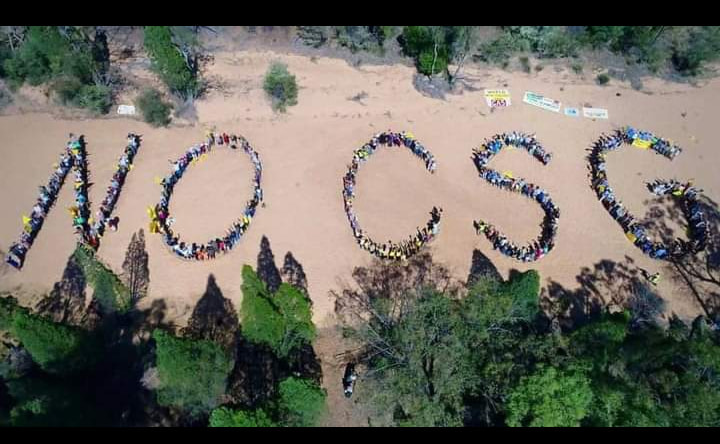“These pipelines represent the head of the snake”, says Coonamble farmer David Chadwick.
“Australia is the biggest gas exporter in the world that has somehow found itself with the some of the dearest energy costs in the world, and a gas shortage. You don’t have to be a rocket scientist to work out this industry has “played” successive decades of politicians and bureaucrats to end up in this mess.
“We are the driest inhabited continent in the world and here is Santos prepared to sacrifice our only secure water supply, the Great Artesian Basin, that sits under 22% of our most productive country.
“The Great Artesian Basin is our only secure water supply and it underwrites our $80b agriculture industry. That is why there is a 97% objection to the project across the five shires that surround Narrabri. No water equals no food. This is food versus gas. You can’t eat coal and you can’t drink gas. What’s going in our grandchildren’s lunchboxes?”
Having squared away governments, as well as both major political parties, the two major media houses and even environment agencies and regulators, Santos faces a last bloody hurdle in its epic battle against local communities to get its Narrabri gas fracking project off the ground. That’s the farmers. It is the farmers which may kill it.
Santos needs to have its gas piped to the Hunter for processing. That means a pipeline; and that means coming onto farmers’ land to survey it, and run a pipeline through.
Gomeroi objections too
Last Friday was a chaotic day for Santos’s Narrabri gas project. NSW Energy Minister Matt Kean issued the company with the authority to force its way onto farmers’ land to conduct surveys for a crucial pipeline, while the Gomeroi people filed an appeal in the Federal court to overrule a decision by the Native Title Authority in support of the project.
The battle for Narrabri is still very much afoot.
According to Peter Wills, Quirindi landowner, “For Matt Kean to sign off on a gas pipeline to be surveyed in 2023 is incredible. He’s just trashed his reputation with that signature.”
Santos’ Narrabri gas project is set to frack for LNG in the Northwest Slopes region of New South Wales. The project would involve drilling up to 850 wells which environmentalists say is highly likely to negatively impact the water table.
Meanwhile, the Gomeroi people have made an appeal to a decision by the National Native Title Tribunal which rules that the public benefit of the gas project outweighed its environmental concerns.
The appeal was filed in the Federal Court late on Friday.
Santos fighting on two fronts
Santos is fighting on two fronts, one in the courts with the Gomeroi people and the other with landholders along the path of a proposed pipeline crucial to getting the project up and running.
“We’ve been fighting it for years and Santos are edging closer to their gas pipeline by purchasing this active project from tinpot operation run by Garbis Simonian,” Wills says.
The Aussie gas producer bought Hunter Gas Pipeline Pty Ltd from a syndicate of owners led by Garbis Simonian in August 2022.
Simonian is a Hunter Valley business figure and founder of Weston Aluminium who donated $5,000 to the Liberal party in 2020. Simonian’s property business partner and major Liberal Party donor Hilton Grugeon was the subject of ICAC’S Operation Spicer, which found Mr Grugeon’ improperly sought to influence MPs’ through prohibited donations.
Hunter Gas Pipeline owns “an approved underground gas pipeline route from Wallumbilla in Queensland to Newcastle in New South Wales. The underground pipeline route passes close to Santos’ Narrabri Gas Project and our goal is to work with infrastructure developers and owners to construct the pipeline and deliver much-needed gas to east coast domestic markets in the shortest timeframe possible”, according to Santos.
Why so Kean?
Then last Friday, NSW Energy Minister Matt Kean gave Santos a tool to force their way into farmers’ land by issuing the company an Authority to Survey (AtS) licence valid for 18 months.
The decision came weeks after farmers travelled to Sydney to stage a protest outside Mr Kean’s electoral office, and demanded he rejected the AtS. They presented a petition opposing the pipeline signed by more than 200 landholders along the route.
The proposed pipeline has been quietly in the works since 2006, which GIPA documents show is when investors first started sniffing. Rudimentary environmental assessments took place in 2009.
Wills says that because they are no easements in place “people have been buying land completely unaware that this project is slated for that property. It really wasn’t until the NSW government had an ATS application that they wrote to every single landholder requested in the AtS and said ‘hey guys you’re affected by a proposal for a gas pipeline through your property.’”
“Some of them were new landholders and many people got a rude shock in August 2022.”
The AtS may not be the nail in the coffin that landholders feared, as there is a condition that states that Santos must exhaust all avenues of negotiation with farmers before getting its Authority to Survey.
The AtS permits Santos to enter lands and carry out surveys to determine the best possible route for the pipeline.
However, before the AtS can be exercised to enter an unwilling farmer’s property they must first “have attempted a reasonable level of negotiation and/or communication prior to using the power of the Authority”.
This is “not going to happen” says David Chadwick, a farmer who has fought against the gas project for the better part of a decade. “There are no substantial landholders who are in favour of this”.
There are 336 landholders affected by the pipeline, and Santos must negotiate with each one to complete their survey. These landholders are “in many respects only just starting to come up to speed. They have a 2009 environmental assessment they might like to read” says Wills.
Simonian and his business partners spent two and a half years attempting to seek these approvals before selling the company to Santos last year.
According to documents uploaded by the NSW Climate and Energy Action team, only 29 landholders signed access agreements out of the 336 landholders affected by the proposed pipeline.
Will it drop the price of gas?
Santos CEO Kevin Gallagher calls the Narrabri project a “100 per cent domestic gas project that will deliver the lowest-cost source of gas for NSW customers.”
The project is slated to produce enough gas to cover half of NSW’s gas needs.
However, gas analysts, like Bruce Robertson from the Institute of Energy Economics and Financial Analysis, are sceptical that much of the gas will remain onshore.
“There just isn’t the demand in Sydney at certain times of the year for NSW to use all the gas available.”
Already in summer lower gas demands from Victorian households, who represent 60% of gas demand, means that LNG being produced in the Bass straight flows “right up to the export plants in Queensland” like Santos owned-Gladstone LNG according to Robertson.
Cui bono?
As a result, “this idea that Narrabri gas is 100% only going to be used in NSW is just wrong. In summer the demand centre is Gladstone and there’s not much demand in Sydney, so when the household gas demand goes down the gas will flow north to the export terminals,” Robertson says.
“Just remember, the big thing about lowering prices is that you actually need a thing called a market. And we don’t have a market on the east coast for gas.”
According to the Australian Competition and Consumer Commission’s latest Gas inquiry interim report, the LNG projects, Gladstone, Curtis and Australia Pacific LNG control around 90% of gas reserves.
“Much of the gas produced in the east coast is produced by the LNG exporters. On an aggregate basis, the LNG exporters and their associates had influence over close to 90% of the 2P reserves in the east coast in 2021, through a combination of their direct interests in 2P reserves, joint venture and exclusivity arrangements. This may increase the risk of coordinated conduct and increase the market power of the LNG exporters” the report reads.
“Whichever way you look at it they determine the price of gas on the east coast. They determine who gets gas and who doesn’t and that’s basically it,” Robertson says.

The proposed route of Hunter Gas Pipeline. Opposing farmers are primarily located in the Local Government areas highlighted (source: Santos)
Gas reservation? Threats by the fossil fuel cartel may force government’s hand



